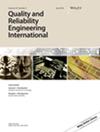A mixed uncertain structural reliability analysis method considering random and convex set variables with correlation
IF 2.8
3区 工程技术
Q3 ENGINEERING, INDUSTRIAL
引用次数: 0
Abstract
In this paper, a mixed model reliability analysis method is put forward for the problem of assessing the reliability of complex engineering structures containing both random and convex aggregate variables. By integrating the ellipsoidal model with correlation and the interval model, the uncertainty region characterized by the ellipsoidal model with correlation is optimized with full consideration of the limited amount of engineering structure sample data, and the risk region represented by the reliability model is redefined, a new mixed reliability assessment criterion is established, and the minimum safe nonprobability reliability index of the structure is built. A key reference is offered by the safety limit diagram of constant reliability indexes set for the first time for the optimal design of engineering structure reliability. The proposed mixed reliability model is compared and analyzed with three classical models. The sensitivity of nonprobability reliability indexes, influenced by random variable parameters and correlation coefficients, is analyzed. This verification confirms that the new reliability model not only provides an accurate assessment of engineering structures' reliability but also lowers the computational demands of engineering design. In this paper, aero-engine blades and wind turbine blades are taken as examples to expound the validity of the reliability model built using this method and its importance to the structural safety analysis of actual engineering.考虑相关随机变量和凸集变量的混合不确定结构可靠性分析方法
本文针对包含随机变量和凸集合变量的复杂工程结构的可靠性评估问题,提出了一种混合模型的可靠性分析方法。通过将带相关性的椭球模型与区间模型相结合,充分考虑工程结构样本数据量的有限性,优化了带相关性的椭球模型所表征的不确定性区域,重新定义了可靠性模型所代表的风险区域,建立了新的混合可靠性评估准则,构建了结构的最小安全非概率可靠性指标。首次设定的恒定可靠度指标安全限值图为工程结构可靠性优化设计提供了重要参考。提出的混合可靠性模型与三个经典模型进行了比较和分析。分析了受随机变量参数和相关系数影响的非概率可靠性指标的敏感性。验证结果表明,新的可靠性模型不仅能准确评估工程结构的可靠性,还能降低工程设计的计算要求。本文以航空发动机叶片和风力涡轮机叶片为例,阐述了利用该方法建立的可靠性模型的有效性及其对实际工程结构安全分析的重要性。
本文章由计算机程序翻译,如有差异,请以英文原文为准。
求助全文
约1分钟内获得全文
求助全文
来源期刊
CiteScore
4.90
自引率
21.70%
发文量
181
审稿时长
6 months
期刊介绍:
Quality and Reliability Engineering International is a journal devoted to practical engineering aspects of quality and reliability. A refereed technical journal published eight times per year, it covers the development and practical application of existing theoretical methods, research and industrial practices. Articles in the journal will be concerned with case studies, tutorial-type reviews and also with applications of new or well-known theory to the solution of actual quality and reliability problems in engineering.
Papers describing the use of mathematical and statistical tools to solve real life industrial problems are encouraged, provided that the emphasis is placed on practical applications and demonstrated case studies.
The scope of the journal is intended to include components, physics of failure, equipment and systems from the fields of electronic, electrical, mechanical and systems engineering. The areas of communications, aerospace, automotive, railways, shipboard equipment, control engineering and consumer products are all covered by the journal.
Quality and reliability of hardware as well as software are covered. Papers on software engineering and its impact on product quality and reliability are encouraged. The journal will also cover the management of quality and reliability in the engineering industry.
Special issues on a variety of key topics are published every year and contribute to the enhancement of Quality and Reliability Engineering International as a major reference in its field.

 求助内容:
求助内容: 应助结果提醒方式:
应助结果提醒方式:


